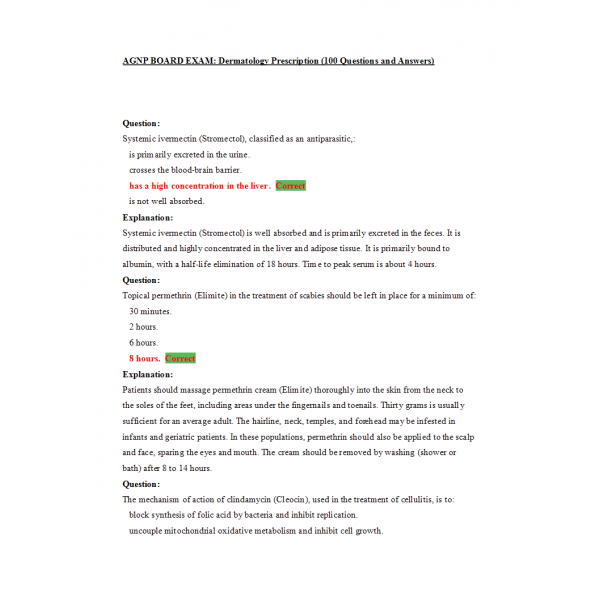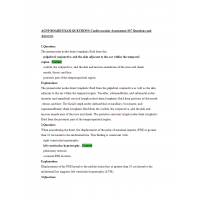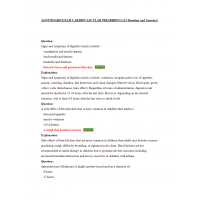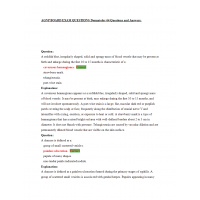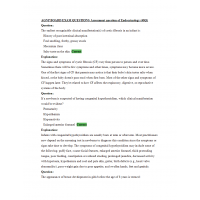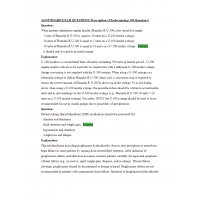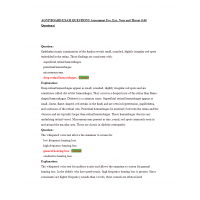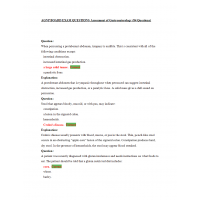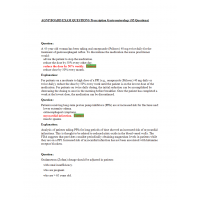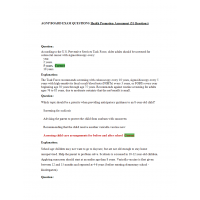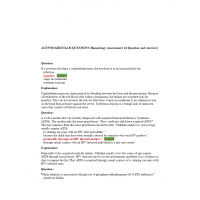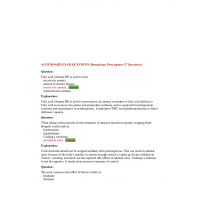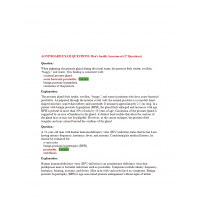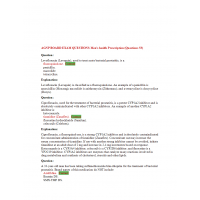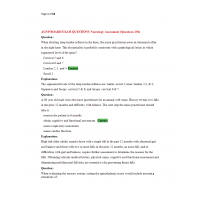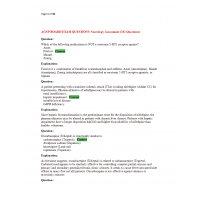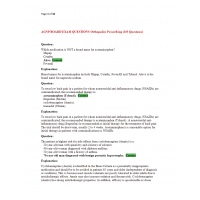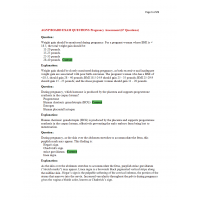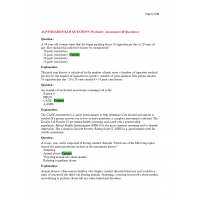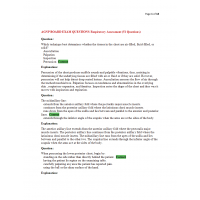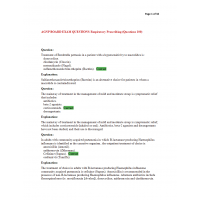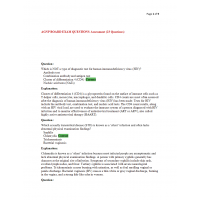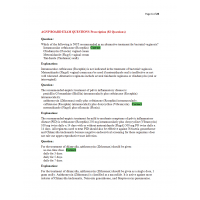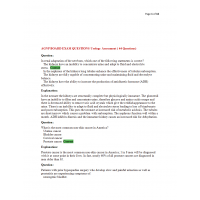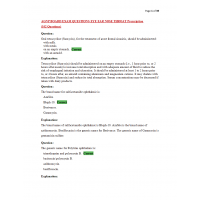AGNP BOARD EXAM: Dermatology Prescription (100 Questions and Answers)
1. Systemic ivermectin (Stromectol), classified as an antiparasitic,:
2. Topical permethrin (Elimite) in the treatment of scabies should be left in place for a minimum of:
3. The mechanism of action of clindamycin (Cleocin), used in the treatment of cellulitis, is to:
4. Tretinoin topical (Retin-A) is indicated for the treatment of acne vulgaris and:
5. The brand name of oral isotretinoin is:
6. Benzoyl peroxide (Benzac wash) is classified as a topical:
7. The generic name for Elidel is:
8. Which of the following conditions is NOT a side effect of long-term use of topical steroids?
9. Patients using fluorouracil (Carac) for the treatment of actinic keratosis should be advised to expect:
10. Tetracycline (Sumycin) is used in the treatment of skin and skin structure infections caused by:
11. The most appropriate therapy for patients with chronic paronychia is a:
12. The use of tetracycline in children younger than 9 years with a bacterial skin infection, may cause:
13. Daily doses of oral corticosteroids, such as prednisone, should be administered:
14. The mechanism of action of sulfa agents, in the treatment of cellulitis, is to:
15. Topical salicylic acid, a keratolytic:
16. Retapamulin (Altabax), used in the treatment of impetigo, is NOT:
17. Initial treatment for irritant contact dermatitis is a:
18. The brand name of clindamycin and benzoyl peroxide topical for the treatment of acne is:
19. Dosage reductions should be considered when prescribing first-generation cephalosporins for patients with:
20. Diclofenac (Solaraze), a topical anti-inflammatory, is used in the treatment of:
21. Antiviral agents for the treatment of herpes zoster:
22. A side effect of benzoyl peroxide (Benzac wash) is:
23. Which of the following is NOT appropriate advice for the patient using benzoyl peroxide (Benzagel)?
24. Clindamycin (Cleocin) should NOT be administered with:
25. Moderate irritant contact dermatitis to the face should be treated with a:
26. Patients treated with sulfamethoxazole and trimethoprim (Bactrim) should be advised to take it:
27. A breastfed infant has been diagnosed with oral candidiasis. Which of the following statements is true?
28. Fluorouracil (Carac), for treatment of actinic keratosis, is classified as a(n):
29. Ciclopirox (Loprox) shampoo for the treatment of seborrheic dermatitis should be applied:
30. Which of the following antibiotics is NOT approved for the treatment of acne vulgaris?
31. The greatest concern with long-term use of topical corticosteroids is:
32. Patients with comedonal noninflammatory acne should be treated with a topical:
33. Dynacin, used in the treatment of skin infections, is the brand name for:
34. Tretinoin topical gel (Atralin) should be used cautiously in patients who are allergic to:
35. A patient received a prescription for clindamycin/benzoyl peroxide topical with orders to dispense 2 containers. Until ready for the use, the patient should store the additional container:
36. Given the same percentage and type of topical corticosteroid, the vehicle with the highest potency would be the:
37. Patients should be advised that clindamycin (Cleocin) should be administered with:
38. The body surface area with the LEAST ability to absorb topical steroids is:
39. The most troublesome adverse reaction to clindamycin (Cleocin), used in the treatment of cellulitis, is:
40. The best treatment for mild cellulitis caused by methicillin-resistant Staphylococcus aureus is:
41. The preferred treatment for Lyme disease in a 16-year-old male is:
42. The most effective way to assure that the patient has enough topical corticosteroid for the duration of treatment is to:
43. Which of the following medications for the treatment of acne is extended-release and is dosed according to weight?
44. To assure maximum efficacy in the treatment of actinic keratosis, fluorouracil (Carac) should be applied for at least:
45. A 23-year-old man has completed 12 weeks of therapy with clindamycin/benzoyl peroxide topical for acne. He should be advised to return immediately if he develops:
46. Due to potential systemic absorption, the use of fluorouracil (Carac) should be avoided in patients who:
47. Topical corticosteroids, used to treat various skin conditions,:
48. Patients should be advised that after an intralesional corticosteroid injection, they should expect:
49. Imiquimod (Aldara) is indicated for the treatment of:
50. Benzoyl peroxide (Benzagel) is indicated for the treatment of:
51. Patients using diclofenac (Solaraze) should be advised to expect optimal therapeutic effect of actinic keratoses within:
52. Which statement about the action of silver sulfadiazine (Silvadene) cream is TRUE?
53. A potential systemic reaction to imiquimod (Aldara), used to treat superficial basal cell carcinomas, is:
54. Patients with seborrheic dermatitis who have patchy, orange to salmon-colored plaques covered with scales should be treated with:
55. Intralesional corticosteroid injections should NOT be:
56. Laboratory monitoring for a patient on cephalexin (Keflex) should include:
57. Prednisolone topical cream belongs to which of the following drug classes?
58. Silver sulfadiazine (Silvadene) cream, indicated for the treatment of burns, is:
59. The use of silver sulfadiazine (Silvadene) cream should be avoided in:
60. Dapsone (Aczone) topical 5% gel should be applied:
61. The recommended first-line treatment of tinea capitis in a 5-year-old child is:
62. Patients applying low-potency steroids to the face should be instructed to:
63. Lidocaine (Lidoderm) patch should NOT be prescribed for patients allergic to:
64. Topical permethrin should be avoided in patients with an allergy to:
65. The most effective therapies in the treatment of acne related to increased sebum production are:
66. A potential adverse reaction related to the use of sulfacetamide (Klaron) topical, indicated for the treatment of seborrheic dermatitis, is:
67. The addition of epinephrine to lidocaine hydrochloride:
68. High-potency topical corticosteroids:
69. First-generation cephalosporins for the treatment of bacterial skin infections:
70. Which of the following is NOT a topical pediculicide?
71. Pediatric patients are at greater risk than adults for developing adrenal suppression related to topical steroid use due to their:
72. The patient receiving imiquimod (Aldara) topical for the treatment of actinic keratosis should be instructed to apply:
73. A combination topical antimicrobial-antibiotic medication used in the treatment of acne is:
74. Children receiving griseofulvin (Grifulvin V) for the treatment of tinea capitis should be monitored for:
75. Which of the following statements about systemic clindamycin (Cleocin) is true?
76. Sulfamethoxazole and trimethoprim (Bactrim) should NOT be prescribed for patients who:
77. The best medication choice for the treatment of acne in hairy areas is:
78. An example of a first-generation cephalosporin is:
79. The half life of trimethoprim-sulfamethoxazole (Bactrim DS) is approximately:
80. Zinc oxide is indicated in the treatment of:
81. A treatment regimen for acne will only be considered ineffective after consistent adherence for at least:
82. Severe nodular acne should be treated with:
83. Patients receiving imiquimod (Aldara) should not receive:
84. Zinc oxide, for the treatment of diaper dermatitis, is classified as a(n):
85. Instructions given to patients being treated with Silver sulfadiazine (Silvadene) cream should NOT include:
86. A patient with psoriasis has a salicylic acid sensitivity and should be instructed to avoid:
87. The initial recommended therapy for patients with moderate postherpetic neuralgia is:
88. Capsaicin topical cream, used to relieve pain related to herpes zoster,:
89. The steps to correctly apply topical permethrin (Nix) in the treatment of pediculosis capitis is to:
90. When administering cephalexin (Keflex) suspension, sometimes used in the treatment of acne vulgaris,:
91. The mechanism of action of oral antifungal agents, used in the treatment of tinea corporis, is to:
92. Oral antibiotics for the treatment of acne vulgaris:
93. The best choice for the relief of painful oral lesions associated with hand foot and mouth disease in children is:
94. Imiquimod (Aldara) is classified as a topical:
95. Pimecrolimus (Elidel) is classified as a topical:
96. Gabapentin (Neurontin), indicated in the treatment of postherpetic neuralgia,:
97. The Fingertip Unit (FTU) method is used when prescribing topical medications. If one arm equals 3 fingertips, approximately how many grams will need to be prescribed for a man who needs BID application to one arm for 7 days?
98. To enhance absorption, tetracycline should be administered:
99. Pimecrolimus (Elidel) is indicated in the treatment of:
100. The generic name for Mycostatin is:
| Institution & Term/Date | |
| Term/Date | AGNP Exam |
AGNP Board Exam Question and Answers - Dermatology Prescription
- Product Code: 2020
- Availability: In Stock
-
$45.00

